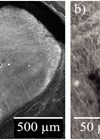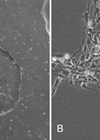In this article, the authors describe three key challenges faced in developing hearing therapeutics. Collaboration between companies, sectors and disciplines will be key to finding solutions.
The unmet need for therapies for hearing loss grows apace, with prevalence rising across the globe and current interventions not meeting all patients’ needs. The World Health Organization warns of a rising tide of noise-induced hearing problems driven by unchecked use of personal listening devices [1]. Increasing evidence suggests ‘social noise’ might impact the listening brain even before damage to hearing thresholds occurs [2,3].
Our inattention to hearing health over the first half of our life course puts later-life hearing at risk, causing additional pressure on health- and social-care systems that struggle to adapt to the needs of our ageing populations. Hearing loss affects our social, physical, and mental health; alarmingly, its appearance in midlife is the greatest potentially modifiable risk factor for dementia [4]. For all these reasons and more, the individual, societal, and economic costs of undiagnosed and untreated hearing loss are substantial. Current technological interventions for hearing loss – hearing aids and cochlear implants – are highly effective in restoring audibility and making speech understandable in quiet conditions, but challenges remain in complex listening environments. Uptake of, and compliance with, hearing aids is often variable. And 40 years of cochlear implantation – a truly transformative technology – has failed to reach a significant proportion of severe to profoundly hearing-impaired users, with accessibility representing a key barrier. For these reasons, novel approaches that protect or restore hearing are urgently required.
Decades of discovery programmes have identified genetic, molecular, and mechano-sensory pathways underlying hearing loss, and therapeutic targets and an active pipeline of drug, gene, and cell therapies are moving towards the clinical domain. Small pharma and biotech start-ups drive current exploration in this field [5,6], many fuelled by venture capital funds, while most large pharmaceutical companies are waiting in the wings. The results of the first trials of novel hearing drugs have been cautiously promising in showing some signs of efficacy. Still, most have failed to reach their clinical endpoint, leaving many cautious about the future of these therapeutic approaches. Within this framework, three specific issues need urgent addressing for the field to progress [7].
"Hearing loss affects our social, physical, and mental health; alarmingly, its appearance in midlife is the greatest potentially modifiable risk factor for dementia"
First, the field of hearing therapeutics lacks a diagnostic toolbox. Despite promising pre-clinical studies, the step into human trials is fraught with unknowns priming the well-described drug-discovery gap. To add value beyond hearing devices, any therapies targeting age-, noise- or drug-induced hearing loss must improve audibility. The audiogram is the ‘gold-standard’ subjective assessment of audibility and is fundamental in hearing aid fitting; it assesses the quietest tones a listener can perceive across a range of sound frequencies [8]. Audibility also encompasses objective measures such as auditory brainstem responses. Improvements in audibility after treatment with novel therapeutics likely represent crucial evidence that these therapeutics can successfully target the cochlear outer hair cells – a primary site of lesion in most forms of hearing loss. Since the same inner-ear mechanisms that make simple sounds detectable also distinguish them from each other, we recommend that these assessments of hearing thresholds be accompanied by basic assessments of frequency discrimination, a practice common in many academic research laboratories. Unlike hearing aids, hearing therapeutic purporting to regenerate sensory hair cells would likely improve audibility and frequency discrimination. However, instead of these basic tests of inner ear function, most trials of novel hearing therapeutics have focused on speech discrimination in quiet and noise.
The focus on speech discrimination is mainly in response to USA Food and Drug Administration (FDA) requirements to address patient-focused outcomes centred on everyday listening problems faced by hearing-impaired individuals. Whilst this is a laudable goal, these endpoints don’t reflect or consider the complex ‘chain of listening’ that involves cognition, language, and social aptitude and, therefore, may obscure any therapeutic efficacy that may take place in the inner ear. The drive for speech-in-noise performance distracts us from the urgent task of delivering solid and likely incremental evidence of therapeutic effects on inner-ear structure and function. One solution might be to develop and validate non-invasive assessments of inner-ear function in pre-clinical animal models suited to human listeners, co-opting the many psycho-acousticians and engineers in this field. There is significant potential, largely unexplored, for those developing hearing therapeutics to engage with researchers worldwide who use sophisticated and high-throughput and high-yield metrics of the neural representation of complex sounds, including human speech, in animal models of normal and impaired hearing. Demonstrating the efficacy of therapeutic intervention in detecting and discriminating simple sounds in human listeners and the neural representation of complex sounds in animal models would represent clear progress to patient benefit.
Second, delivering therapeutics to the inner ear is complex and poorly understood [9]. The kinetics of drugs, cells, and genes - how they arrive at, are distributed, absorbed, or delivered by, and excreted and eliminated from target cells and tissues - remain largely unknown. The same applies to pharmacodynamics; how a hearing therapy acts at its intended target (and possibly unintended off-target tissues and cells). Without a better fundamental knowledge of these processes, many aspects of therapeutic development remain a ‘moon-shot’. Using implantable devices, such as cochlear implants could provide solutions to the challenges around therapeutic delivery to the site of lesion and in assessing efficacy.
Cochlear implant companies are exploring this potential to provide intra-cochlear delivery of drugs and genes in combination with their devices to improve patient outcomes [10]. Cochlear implants currently incorporate an e-physiology suite that can assess biomarkers of inner-ear function, including that of the auditory nerve. The future of bioengineering here is bright, with the potential to expand and refine in-situ and ongoing monitoring of inner-ear health and responses to therapeutic interventions.
Third, the population of patients with sensorineural hearing loss is poorly understood, particularly those with adult-onset hearing loss.Recent insights into genetic and molecular mechanisms of hearing loss have not been met by similar advances in phenotyping hearing loss across large populations of patients. The lack of patient phenotyping means that the effects of highly targeted novel therapies may be missed or diluted by a lack of stratification of patients regarding causes of hearing loss that would match intended targets.
It is crucial to develop the patient cohorts and high-dimensional data repositories that allow for deep geno- and pheno-typing of hearing loss and stratification of trial-ready patient groups. Public and private investments and cross-border collaborations will be needed to overcome the logistical, commercial, and political complexities of achieving this.
At the recent Inner Ear Disorders Therapeutics Summit held in Boston in June 2022, the largely industry-based attendees deliberated the status of the field. They articulated the challenges faced in their development pipelines. Diagnostics, delivery, and patient stratification were central to this conversation. Refreshingly, there was explicit acknowledgment and consensus that no single company was likely to ‘crack the case’ in the near-to-medium term. Collaborating to progress hearing therapies to market and clinical use could be mutually beneficial. The recent cochlear implant consensus statement [11] demonstrates this can be achieved across commercial companies. Academic and clinical key opinion leaders can broker these delicate partnerships well. The first action of such a partnership could be to develop a programme of pre-competitive research engagement and funding activities geared towards solving problems common to all programmes of therapeutic interventions for hearing loss.
References
1. World Health Organization. World Report on Hearing. Geneva, Switzerland. 2021.
www.who.int/publications/i/
item/world-report-on-hearing
Last accessed August 2022.
2. Kujawa SG, Liberman MC. Adding insult to injury: cochlear nerve degeneration after “temporary” noise-induced hearing loss. J Neurosci 2009;29(45):14077-85.
3. Monaghan JJM, Garcia-Lazaro JA, McAlpine D, Schaette R. Hidden Hearing Loss Impacts the Neural Representation of Speech in Background Noise. Curr Biol 2020;30(23):4710-21.e4.
4. Livingston G, Sommerlad A, Orgeta V, et al. Dementia prevention, intervention, and care. Lancet 2017;390(10113):2673-734.
5. Schilder AGM, Su MP, Blackshaw H, et al. Hearing Protection, Restoration, and Regeneration: An Overview of Emerging Therapeutics for Inner Ear and Central Hearing Disorders. Otol Neurotol 2019;40(5):559-70.
6. Schilder AGM, Su MP, Mandavia R, et al. Early phase trials of novel hearing therapeutics: Avenues and opportunities. Hear Res 2019;380:175-86.
7. Isherwood B, Gonçalves AC, Cousins R, Holme R. The global hearing therapeutic pipeline 2021. Drug Discov Today 2022;27(3):912-22.
8. Vermiglio AJ, Soli SD, Fang X. An Argument for Self-Report as a Reference Standard in Audiology. J Am Acad Audiol 2018;29(3):206-22.
9. Anderson CR, Xie C, Su MP, et al. Local Delivery of Therapeutics to the Inner Ear: The State of the Science. Front Cell Neurosci 2019;13:418.
10. Pinyon JL, von Jonquieres G, Crawford EN, Duxbury M, et al. Neurotrophin gene augmentation by electrotransfer to improve cochlear implant hearing outcomes. Hear Res 2019;380:137-49.
11. Buchman CA, Gifford RH, Haynes DS, et al. Unilateral Cochlear Implants for Severe, Profound, or Moderate Sloping to Profound Bilateral Sensorineural Hearing Loss: A Systematic Review and Consensus Statements. JAMA Otolaryngol Head Neck Surg 2020;146(10):942-53.
Declaration of competing interests: In DM’s role as Academic Director of Macquarie University Hearing, he undertakes and supports research funded by a range of hearing technology and therapy companies. In AS’s role as Director of the NIHR UCLH BRC Hearing Health Theme, she advises companies and academic organisations on the design and delivery of clinical trials of novel hearing therapeutics.












